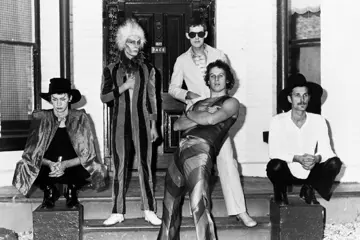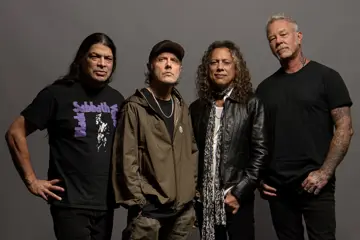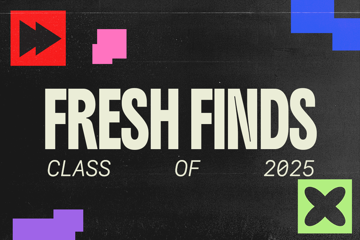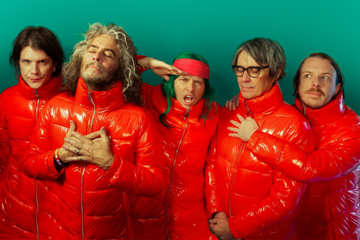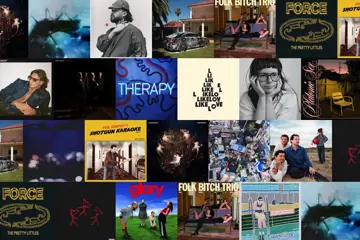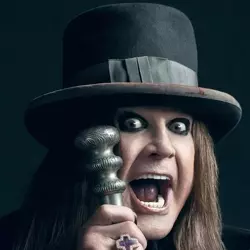 Ozzy Osbourne
Ozzy OsbourneOzzy Osbourne’s passing has reignited the 50-year debate over who exactly “invented” heavy metal – Led Zeppelin or Black Sabbath?
True, the term “heavy metal” was coined in a review in America’s Rolling Stone magazine to describe Zeppelin’s first album.
The phrase was from Steppenwolf’s Born To Be Wild, which went: "I like smoke and lightning / Heavy metal thunder / Racin' with the wind / And the feelin' that I'm under".
The term “heavy metal” had already been used by US countercultural novelist William S. Burroughs in the early ‘60s in The Soft Machine and Nova Express. In the latter, it was a metaphor for addictive drugs.
Sabbath fans argue vehemently that Ozzy and his cohorts’ brand was the most primal and authentic.
Both bands formed in 1968. Sabbath came together in the northern English town of Birmingham. Zep’s singer/lyricist and drummer came from the same town.
At the time, Birmingham was a grey industrial city with rising young unemployment and strikes. It was also known for its black magic rituals and ominous atmosphere.
Zep’s heavy rock encapsulated Celtic mists, Viking folklore, and, in the case of Whole Lotta Love, brought the blues into the space age.
Don't miss a beat with our FREE daily newsletter
Sabbath captured that whole doom-gloom mentality of the town. Their first album, cut in two 12-hour sessions and released on Friday 13, came out with little fanfare.
But it still found an audience, both in the UK and also in Australia and Europe, which had similar bleak cities.
Paranoid broke them worldwide – reaching #18 in Australia in 1971.
What gave Sabbath its brutal attack – one which allowed Ozzy to expand his maniac personality on stage – was an accident 17-year-old Tony Iommi had working in a sheet metal factory.
He lost the tips of the middle and ring fingers of his right hand (his fret-board hand, since he is left-handed) and was told, “You’ll never play again.” Iommi fitted homemade thimbles made from an old Fairy Liquid soap bottle to his injured fingers to extend and protect them.
He couldn’t feel the strings, so he pressed down on them hard. He had difficulty bending strings, so he used ultra-light banjo strings. He tuned his guitar to lower pitches, sometimes as far as three semitones below standard guitar tuning.
That gave Black Sabbath a thunderous sound.
So put aside who came up with heavy metal first. Here are seven tracks that went on to inspire the metal genre of music.
The Jimi Hendrix Experience – Purple Haze (March 1967)
The riff to Purple Haze was so compelling that when Jimi Hendrix’s producer and manager Chas Chandler heard the maestro try it for the first time at his flat in London, he exclaimed, “That’s the next single!”
At Chandler’s urging, Hendrix finished the song off in the dressing room of a club during the afternoon of December 26, 1966, before a gig.
Purple Haze made its mark, thanks to its inspired playing, blending blues and Eastern motifs, along with multi-track recording technology, sped-up effects, and a solo that utilised the Octavia guitar effects unit, developed by electronics engineer Roger Mayer, for the first time with Hendrix.
A later track, Voodoo Child (Slight Return), with more intense in-your-face guitar work, wah wah effects and backward loops, and a nod to superstition and black magic, was a greater metal blueprint.
Iron Butterfly – In-a-Gadda-da-Vida (June 1968)
Coming out of San Francisco’s acid-rock scene, In-a-Gadda-da-Vida had that horror rumble and devil-speak so beloved of later metal merchants.
It was written by singer Doug Ingle and originally titled In The Garden Of Eden, inspired by his father, who played the organ in the church.
At a rehearsal, Ingle consumed a gallon of Red Mountain wine. So, when he slurredly relayed the lyrics to the rest of the Butterfly, the drummer wrote it down incorrectly.
However, the record company loved the new title because of its exotic sound. The original version was 17 minutes.
It took up the entire side of their album of the same name, which sold 4 million copies. It wasn’t meant to be 17 minutes. They were in the studio waiting for the producer to arrive, and did an extended jam on it for the engineer to get the right levels.
When they played it back, they figured it worked, little mistakes and all. An edit shaved down to 2:52 minutes was lifted as a single. It’s been used in everything from horror movies to a The Simpsons episode (Bart Sells His Soul) and sampled by rapper Nas.
Blue Cheer – Summertime Blues (January 1968)
In the late ‘60s, San Francisco band Blue Cheer (named after a LSD variant) were one of the loudest around. So ear-splitting in fact that after the first three songs, crowds would be fleeing.
Jim Morrison of The Doors hailed them as "the single most powerful band I've ever seen," while Eric Clapton’s observation was they were "probably the originators of heavy metal". The band themselves loved the fact people “either loved us or hated us. We’re a rock band after all.”
Their debut album, Vincebus Eruptum, is regarded by some as the first metal long player. It was engineered by an off-duty cop who’d never worked with a band like them. One mix accidentally wiped the drums out.
Summertime Blues was a 1958 teen angst song co-written and sung by 19-year-old Eddie Cochran. His “rebel with a cause” image was cemented when he died two years later in a car crash.
The song was covered by The Who, The Beach Boys, T. Rex, Rush and Alan Jackson. The Blue Cheer version made it to #14 in the US.
The Beatles – Helter Skelter (November 1968)
The story started when Paul McCartney was reading an interview by Pete Townshend in a music paper. The Who guitarist was talking up their latest single I Can See For Miles as "The most raucous rock 'n' roll, the dirtiest thing ever done."
That aroused the fighting spirit in Macca. He later recalled in Mojo magazine (October 2008) that he went to the studios and told the other Beatles, ‘Look, I've got this song but Pete said this and I want to do it even dirtier.'
“It was a great brief for the engineers, for everyone - just as fuzzy and as dirty and as loud and as filthy as you can get it is where I want to go.”
The first version of Helter Skelter, recorded on July 18, 1968, ran for 27 minutes. It has never been released.
On the same day, they also tried out a slower and less aggressive rendition. A third 4:37-minute version emerged on The Beatles Anthology, Volume III.
They regrouped on September 9 when they did no less than 21 takes, each five minutes long. The final version appeared on The White Album. That’s when Ringo Starr shouted out, "I've got blisters on my fingers!"
The drummer would reveal to The Miami Herald (June 29, 2008), "The track was actually very long, and we were just pounding. It was a jam, really; it turned into that.
“And at the end, the only way off the kit was, 'Look, my fingers are bleeding, and I just have to get up.' And I decided to shout it."
Nirvana’s Kurt Cobain was one who considered Helter Skelter the first metal song ever.
The history of metal is littered with crackpots who saw weird scenarios in its songs. Helter Skelter was no different.
Cult leader Charles Manson somehow saw the nonsensical lyrics about a slide in an amusement park as forecasting a massive racial war coming to America.
He sent his disciples to the Californian homes of two wealthy celebrities to stab them to death and blame the Black Panthers.
When quizzed about this, John Lennon shrugged, "He's balmy, like any other Beatle-kind of fan who reads mysticism into it. I don't know what Helter Skelter has to do with knifing somebody. I've never listened to the words, properly. It was just a noise."
MC5 – Kick Out The Jams (February 1969)
“Kick Out The Jams” was a catchphrase in the American counterculture about breaking down society’s norms and starting fresh.
But MC5 (Motor City 5, a tribute to their home town Detroit, aka Motor City) first meant it in another way. As the band in residence at a ballroom, they’d open for major bands coming through Detroit.
As guitarist Wayne Kramer would say, “They weren’t very good. Or they’d just be indulgent and jamming. So we used to shout at them, ‘Kick out the jams, stop jamming and PLAY or get off the stage mothefuckers!’ We knew that one day we’d write a song with that title.”
The use of “motherfuckers!” caused a furore with some retailers when it was released as a single from a gritty live album with the same name –even after the offending line was cleaned up to “brothers and sisters”.
The band took out an ad in an underground newspaper stating “Fuck Hudson’s!” The department store chain threatened to pull out all the records from the Elektra label, including The Doors, Love, Tim Buckley and Judy Collins.
MC5 were eventually dropped by the label.
The song has been covered by the likes of Jeff Buckley and Rage Against The Machine, and considered as much a taste of early metal as garage punk.
The Stooges – I Wanna Be Your Dog (August 1969)
With its fuzz guitar, manic chord changes and heavy distortion, I Wanna Be Your Dog was as much a metal-shaper as a punk rock pioneer.
It was the first single by The Stooges, who formed in 1967 in Ann Arbor, Michigan as The Psychedelic Stooges. Their singer Iggy Pop would psyche up for shows – “I just do Chinese exercises and visualisations to get it together” – which featured outrageous antics including rolling on glass and vomiting on stage.
I Wanna Be Your Dog, about wanting to be seduced by a woman, was written while Pop sat on the banks of a Chicago river smoking a joint.
He explained to US radio show host Howard Stern, "Have you ever seen like a really good-looking girl, really nicely dressed, and she's walking down the street with her dog, right? And like her dog is... intimate with her body, and she likes him and everything.
“Basically, it's the idea of I want to unite with your body. I don't wanna talk about literature with you or judge you as a person. I wanna dog you."
It was a source of glee for The Ig that the song would continue to polarise rock audiences decades down the track, as much as it was heavily used in films and TV shows and covered by Nirvana, Sonic Youth, Hole, Sex Pistols, Slayer and Joan Jett.
The Kinks – All Day And All Of The Night (October 1964)
It may be drawing a long bow to say a song from 1964 set the tone for heavy metal.
But in October 2009, at the 25th anniversary celebrations of the Rock And Roll Hall Of Fame in New York’s Madison Square Gardens, Metallica’s James Hetfield told the crowd as he introduced the Kinks leader Ray Davies, “We got completely schooled on early riff-rock by this man and his band – The Kinks.”
Black Sabbath, The Clash, Thunder and The Who were just some who publicly acknowledged being inspired by one of the group’s songs.
The Doors’ 1968 single Hello, I Love You had a strong similarity (denied by the US band) which led to a court case.
Initially, executives at The Kinks’ record label didn’t want to release it as their third single. They considered it “low brow” and its guitar sounds “like a dog barking”. It was a hit through Europe and the US and reached #14 in Australia.
All Day And All Of The Night was cut in three takes in a London studio on a September morning.
Ray himself would say to Classic Rock: “The sounds on that one, if they were made today, would sound like Green Day or a metal band.”
Guitarist Dave Davies got that distinctive distorted sound due to an argument with his partner at the time. In a rage, he slashed the speaker cones of his amp with a razor. “As it vibrated, it produced a distorted and jagged roar,” he explained.
The signature sound was also dominant on The Kinks’ earlier hit, You Really Got Me, which was covered by Van Halen on their debut album almost 15 years later.
There was another metal connection on All Day And All Of The Night. Jimmy Page, then doing countless sessions for everyone in London before forming Zeppelin, claimed he was brought in to play the guitar on the track and also the tambourine.
The track producer, Shel Talmy, said Page did play on the Kinks’ first album. But not this track.
In a 1981 interview with Creem, Ray recounted, "I remember Page coming to one of our sessions when we were recording All Day And All Of The Night.
“We had to record that song at 10 o'clock in the morning because we had a gig that night (in Birmingham). It was done in three hours.
“Page was doing a session in the other studio, and he came in to hear Dave's solo, and he laughed and he snickered. And now he says that he played it!
“So I think he's an asshole, and he can put all the curses he wants on me because I know I'm right and he's wrong."




